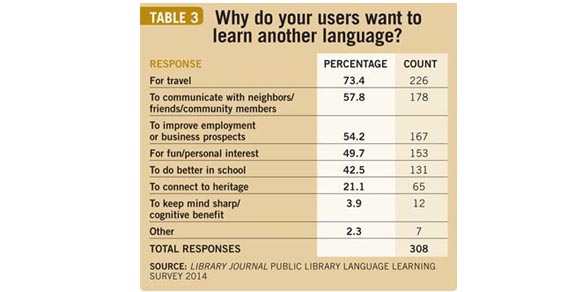
We have all likely felt the pressure, at one time or another, to grow more competent in a foreign language. Now, public librarians across the country are feeling the pressure to provide more diverse and accessible language learning products and services. Library Journal recently conducted a survey of public librarians from 337 libraries across the United States on language learning programs. Not surprisingly, the consensus across the board is that demand for language learning services has at least remained steady (47%), and has likely risen (47%), in recent years.
So what is prompting patrons to seek out language instruction? While travel still hangs on as the biggest reason for a patron to pursue foreign language learning, over half of the librarians surveyed responded that communicating with neighbors and community members (58% of librarians), and furthering business prospects (54% of librarians), were primary reasons. In an increasingly diversifying country, there is a heightened perception that learning a second language is no longer a luxury. Spanish and English for Speakers of Other Languages (ESOL) are the most frequently demanded languages, yet only 61% of librarians thought their ESOL programs were satisfactory.
Additionally, patrons want more than ever to be able to do their language lessons on the move. Almost all of the librarians surveyed (90%) noted ease of access as the most important characteristic of language resources, and mobile apps are on the rise. The downside of this trend is that many of the librarians surveyed expressed frustration at the limited means to promote online language software. Patrons are often unaware of services beyond books or audio.
It appears that for the foreseeable future, all kinds of language learning resources but especially online and mobile platforms will see steady if not escalating demand, and librarians will have to determine how to best inform and educate patrons about available resources.
The article by Library Journal also provides a list of offerings for libraries interested in bringing language learning software into their library.
Note: This post is part of our series, “The Weekly Number.” In this series, we highlight statistics that help tell the story of the 21st-century library.